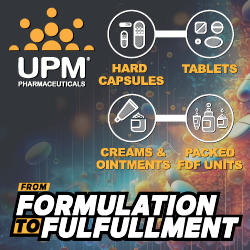Issue:May 2024
EXECUTIVE INTERVIEW - Cocrystal Pharma: Utilizing Structure-Based Technologies to Provide First- & Best-In-Class Antiviral Drugs to Address Critically Unmet Medical Needs
 Cocrystal Pharma, Inc. (Nasdaq: COCP) is a clinical-stage biotechnology company discovering and developing novel antiviral therapeutics that target the replication process of influenza viruses, coronaviruses (including SARS-CoV-2), and noroviruses. Cocrystal employs unique structure-based technologies and Nobel Prize-winning expertise to create first- and best-in-class antiviral drugs. Despite the numerous strains that may exist or emerge, these enzymes are required for viral replication and are essentially highly conserved across all strains. By targeting these highly conserved regions of the replication enzymes, our antiviral compounds are designed to exhibit a broad-spectrum activity and tested to be effective against resistant variants. Drug Development & Delivery recently interviewed Dr. Sam Lee, Cocrystal Pharma’s President and co-CEO, to discuss the company’s latest achievements in antiviral drug development.
Cocrystal Pharma, Inc. (Nasdaq: COCP) is a clinical-stage biotechnology company discovering and developing novel antiviral therapeutics that target the replication process of influenza viruses, coronaviruses (including SARS-CoV-2), and noroviruses. Cocrystal employs unique structure-based technologies and Nobel Prize-winning expertise to create first- and best-in-class antiviral drugs. Despite the numerous strains that may exist or emerge, these enzymes are required for viral replication and are essentially highly conserved across all strains. By targeting these highly conserved regions of the replication enzymes, our antiviral compounds are designed to exhibit a broad-spectrum activity and tested to be effective against resistant variants. Drug Development & Delivery recently interviewed Dr. Sam Lee, Cocrystal Pharma’s President and co-CEO, to discuss the company’s latest achievements in antiviral drug development.
Q: What is the approach you are currently taking to address the replication of viruses where we have seen current therapies fail??
A: Our unique structure-based drug discovery platform provides a 3-D structure of inhibitor complexes at near-atomic resolution and immediate insight to guide Structure Activity Relationships. This helps us identify novel binding sites and allows for a rapid turnaround of structural information through highly automated x-ray data processing and refinement. By targeting viral replication enzymes and protease, we believe it is possible to develop an effective treatment for all coronavirus diseases, including COVID-19, Severe Acute Respiratory Syndrome (SARS), and Middle East Respiratory Syndrome (MERS), as well as other common viruses like influenza A and norovirus. Our main SARS-CoV-2 protease inhibitors showed potent in vitro pan-viral activity against common human coronaviruses, rhinoviruses, and respiratory enteroviruses that cause the common cold, as well as against noroviruses that is the leading cause symptoms of acute gastroenteritis.
Q: What have been the underlying issues with current treatments?
A: The fact is patients suffering from these acute and chronic viral infections have few effective treatments. Some available options have characteristics that limit their market potential such as pricing, poor tolerance, inconvenient administration, ineffectiveness against some viral subtypes and/or resistance. We are working to develop best-in-class antiviral therapies that are effective against all viral subtypes that cause disease and also address viral resistance.
Q: What are the unique advantages of your technology?
A: Our drug candidates are being designed to be effective on the broad range of viruses causing the disease. It is the different strains that emerge over time that help to develop treatment resistance, as well as vaccine resistance. This is one reason we see multiple generations of vaccines emerging to address the different variants emerging with SARS-CoV-2. Many antiviral drugs available today are effective only against certain strains of viruses and are less effective or not effective at all against other strains. Our drug candidates, in addition to addressing the virus itself, also specifically target those proteins involved in viral replication. Despite the viral strains, these replication enzymes are essentially identical (i.e., highly conserved) among all strains of a given virus. By targeting these conserved replication enzymes, we believe our antiviral compounds will show to be effective against major virus strains. Replication enzymes are generally conserved not only among subtypes of a given virus, but also among different viruses.
Q: Can you discuss your lead program with influenza A?
A: Each year, there are approximately 1 billion cases of seasonal influenza worldwide, with 3-5 million severe illnesses and up to 650,000 deaths, according to the World Health Organization. On average, about 8% of the US population contracts influenza each season. In addition to the health risk, influenza is responsible for approximately $10.4 billion in direct costs for hospitalizations and outpatient visits for adults in the US annually. As we’ve generally discussed, many antiviral treatments for influenza are only partially effective and prone to viral resistance. As the flu changes year by year, approved treatments like oseltamivir, zanamivir, and Xofluza®, are becoming less and less effective.
There are three types of influenza viruses: A, B, and C with the A and B viruses being the significant human respiratory pathogens that cause seasonal flu. Influenza A viruses are historically responsible for multiple major influenza pandemics worldwide. We have developed novel, broad-spectrum antivirals that are specifically designed to be effective against all significant pandemic and seasonal influenza strains, and to have a high barrier to resistance due to the way they target the virus’ replication machinery.
CC-42344 inhibits the first step in influenza A’s viral replication by binding to a highly conserved PB2 site of the influenza A polymerase complex and exhibits a novel mechanism of action that inhibits viral replication.
In vitro testing showed CC-42344’s excellent antiviral activity against influenza A strains, including pandemic and seasonal strains, as well as against strains resistant to Tamiflu® and Xofluza, while also demonstrating favorable pharmacokinetic and safety profiles. We conducted a healthy volunteer Phase 1 study with oral CC-42344 in Australia and in late 2022, we reported favorable safety and tolerability results from that study.
Now we are conducting a randomized, double-blind, placebo-controlled influenza Phase 2a human challenge study in the United Kingdom to evaluate safety and viral and clinical measures in healthy volunteers who are challenged with influenza A. We expect to report topline results from the Phase 2a clinical study this year.
Q: How are you addressing norovirus?
A: Although norovirus is a worldwide public health problem, there are no effective treatments or vaccines. Norovirus afflicts an estimated 685 million people annually at an estimated societal cost of $60 billion. About 200 million cases are seen among children under 5 years old, leading to an estimated 50,000 child deaths every year, mostly in developing countries, according to the Centers for Disease Control and Prevention (CDC). CDI-988 in vitro studies showed potent broad-spectrum antiviral activity against a panel of pandemic GII.4 norovirus proteases, which have caused the majority of norovirus outbreaks worldwide since 2002, and a favorable pharmacokinetic property targeting the gastrointestinal tract. Our compound CDI-988 targets a highly conserved region in the active site of the main 3CL protease required for viral RNA replication for pandemic norovirus and coronaviruses, including SARS-CoV-2. CDI-988 is a breakthrough discovery of the first-in-class pan-coronavirus and pan-norovirus antiviral agent with potential efficacy in these two indications. It is currently being evaluated for safety and pharmacokinetics in a randomized, double-blinded, placebo-controlled Phase 1 study in healthy subjects being conducted in Australia.
Q: COVID continues to be an issue as well. Is the approach to addressing this similar?
A: We chose CDI-988 as our lead candidate for the treatment of coronaviruses, including SARS-CoV-2, the virus that causes COVID-19, as well as for noroviruses. CDI-988 was specifically designed and developed as a broad-spectrum antiviral inhibitor using our proprietary structure-based drug discovery platform technology to target a highly conserved region in the active site of coronaviruses, noroviruses, and other 3CL viral proteases. As I previously mentioned, we believe CDI-988 is a first-in-class pan-coronavirus and pan-norovirus antiviral agent with potential efficacy in both indications.
As you may know, COVID is a coronavirus. Coronaviruses (CoV) are a family of viruses that historically have been associated with a wide range of responses, from no symptoms to more severe disease that includes pneumonia, acute respiratory distress syndrome (ARDS), kidney failure, and death. The ability of someone with no symptoms to transmit infection to another person heightened the public health challenge of COVID. By targeting the viral protease, we believe it is possible to develop an effective treatment for all coronaviruses, including SARS-CoV-2 and its variants, SARS and MERS.
We see great promise with both of CC-42344 and CDI-988 drug candidates as potential effective easy to administer treatments for highly contagious, pandemic viruses, while also providing significant market opportunities for Cocrystal. Following a highly productive year in 2023, we expect to report topline data from our Phase 2a influenza and our Phase 1 CDI-988 studies this year.
Total Page Views: 4282













